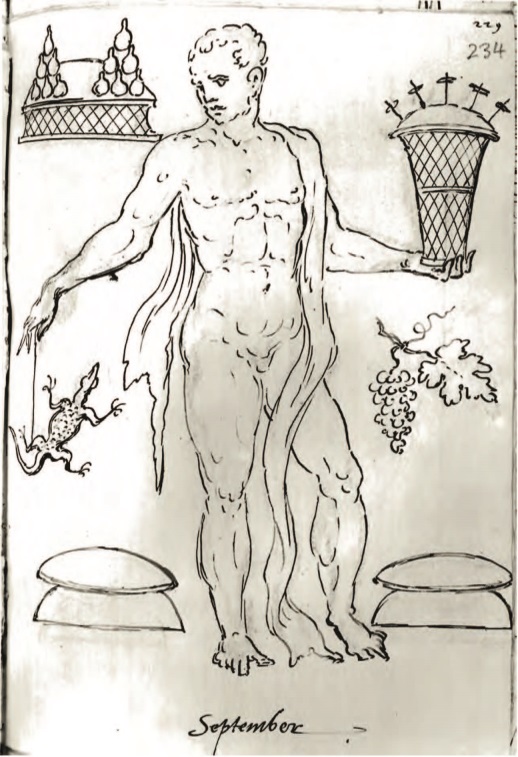For December, the images are preserved in the usual four manuscripts. The poems are mainly preserved in various unillustrated manuscripts, but also appear in R1, the Barberini manuscript.
Here is the 4-line poem (tetrastich):
Annua sulcatae connectens semina terrae
Pascit hiems; pluvio de Iove cuncta madent.
Aurea nunc revocet Saturno festa December,
Nunc tibi cum domino ludere, verna, licet.Mixing the furrowed earth with the annual seed-sowing,
Winter lets them grow; all things are soaked by the rain from Jove.
Now let December bring back the golden feast days of Saturn;
Now, slave, you are permitted to joke with your master.
The first two lines refer to the activities of the season, the last two relate to the image in the manuscripts.
The 2-line verse (distich) is as follows:
Argumenta tibi mensis concedo December
Quae sis quamvis annum claudere possisI leave the subjects of the month to you, O December;
You can end the year however you like.
The second line is, apparently hopelessly corrupt and is variously emended. Housman suggested instead:
Argumenta tibi mensis concedo Decemb<ris>,
Qui squamis annum claudere piscis <amas>.
The image for the month is about Saturnalia, naturally enough. It shows a slave in front of a gaming table with lion-feet. On the table are dice and a dice tower, for random throwing. A theatrical mask hangs over his right shoulder. In his left hand he holds a full-height torch, and a flock of birds hangs on a hook behind that. Some sort of heart-shaped vegetable lies by his left foot.
The most faithful representative of the renaissance copies is the Barberini manuscript, R1 – MS Vatican Barberini lat.2154, part B, f.23r:

This has the tetrastich written in the right margin, obviously later. The first line of the distich is underneath the frame.
The Brussels copy makes the theatrical mask more obvious:

The Berlin copy:

The scene is redrawn in the16th century Vienna manuscript 3416, folio 37 (online here):

As ever, Divjak and Wischmeyer supply the details of what is shown here.
And here we are – the end. Io Saturnalia! Merry Christmas!
(For more information on this series of posts, please see the Introduction to the Poems of the Chronography of 354).























